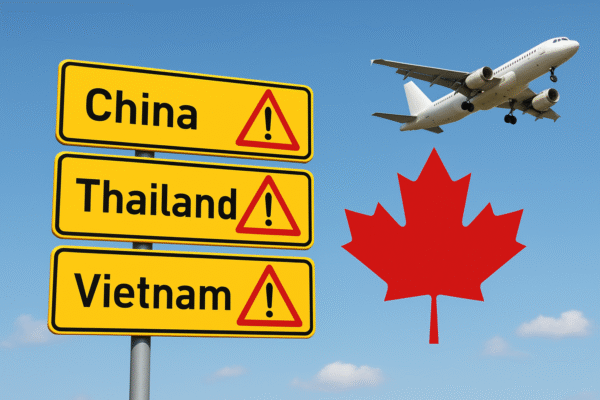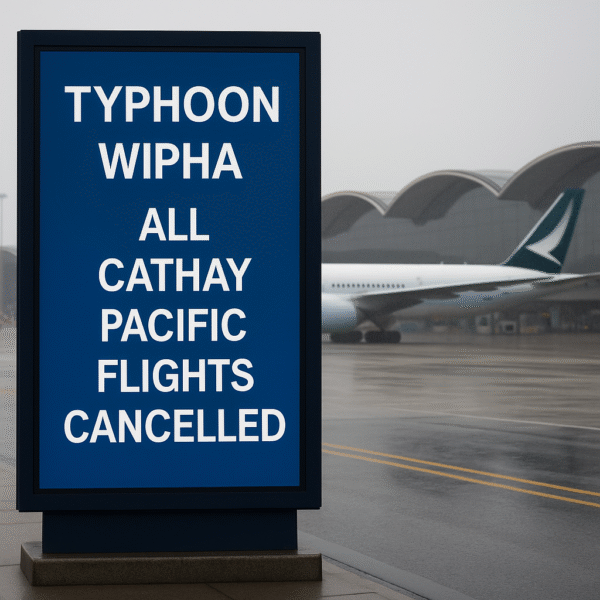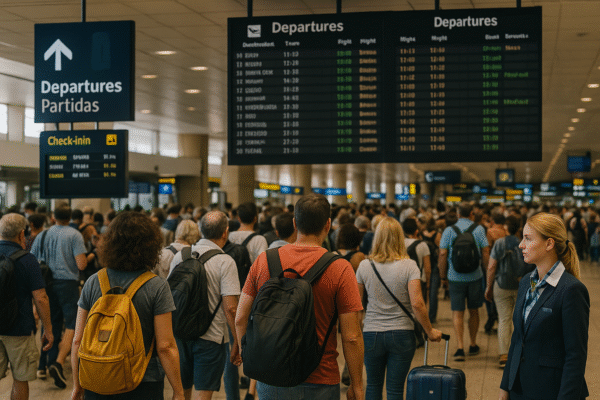China’s aviation network plunged into unprecedented disruption this week as extreme weather, airspace congestion, and operational bottlenecks caused hundreds of flight cancellations and delays across 12 major airports. Affected passengers flying with major international carriers—including Air China, Japan Airlines, Singapore Airlines, Emirates, Cathay Pacific, AirAsia, United Airlines, and others—faced hours-long delays, stranded terminals, and mass rescheduling efforts.
The worst-hit airports include Shanghai Pudong, Guangzhou Baiyun, and Shenzhen Bao’an, which together process tens of millions of domestic and international passengers each year. More than 1,500 flights were delayed and over 250 flights cancelled on a single day, highlighting severe strain on China’s aviation infrastructure during the peak summer season.
Chaos Unfolds Across China’s Top Aviation Hubs
The delays were triggered by a rare convergence of factors: convective thunderstorms across southern China, tightly regulated civil-military airspace corridors, and pandemic-induced staffing shortages. According to China’s Civil Aviation Administration (CAAC), over 20% of flights across the country were either delayed or canceled between July 17–18, 2025.
Here’s a breakdown of major affected airports and the scope of disruptions:
| Airport | Delays | Cancellations |
|---|---|---|
| Guangzhou Baiyun International | 305 | 14 |
| Shanghai Pudong International | 250 | 29 |
| Shenzhen Bao’an International | 172 | 104 |
| Kunming Changshui International | 165 | 20 |
| Xi’an Xianyang International | 176 | 7 |
| Beijing Daxing International | 92 | 15 |
At Guangzhou Baiyun Airport, passengers flying Emirates, Cathay Pacific, and United Airlines experienced delays of over six hours, with some flights rerouted or cancelled entirely. Shanghai Pudong, China’s busiest international hub, was forced to suspend operations intermittently due to lightning storms and apron flooding.
Airlines Grapple With Operational Fallout
Leading carriers across Asia, the Middle East, and North America scrambled to manage the fallout. Among the most affected:
- Singapore Airlines deployed additional ground staff at Shanghai Pudong and rerouted flights via Bangkok and Taipei.
- Emirates cancelled flights between Dubai and Guangzhou, offering full rebooking refunds and alternative routing via Hong Kong.
- Cathay Pacific faced cascading schedule issues at Shenzhen and Kunming due to inbound delays.
- United Airlines rerouted some Pacific-bound services through Seoul and Tokyo due to slot unavailability at Chinese hubs.
- AirAsia, operating heavily from Southeast Asia into Chinese cities, reported severe disruptions at Kunming and Shenzhen.
According to CAAC’s live flight tracker, China Eastern Airlines alone accounted for over 400 delays and 60 cancellations across its domestic network, underscoring how localized issues had system-wide ripple effects.
Passenger Experience: Stranded and Confused
Passengers flooded Weibo and Xiaohongshu with photos of chaotic terminals, tarmac gridlocks, and long queues. At Shenzhen Bao’an, travelers were held in aircraft for over three hours as gates remained occupied by delayed arrivals. Pudong Airport witnessed breakdowns in baggage systems and unclear gate assignments, compounding traveler frustration.
Foreign visitors reported difficulties accessing timely information due to limited multilingual support and app-based notification glitches. Many tourists in transit were left without food or hotel accommodations as staff struggled to process rebookings in real time.
Root Causes Go Beyond Weather
While the typhoon-season storms were the immediate trigger, aviation experts point to structural flaws that exacerbated the chaos:
- Limited runway capacity and poor weather resilience at major airports
- Restricted airspace zones due to military prioritization, forcing route bottlenecks
- Understaffed ground operations, particularly in baggage handling and refueling
- Outdated digital communication tools for real-time traveler updates
China’s rapid air travel recovery post-COVID—projected by IATA to exceed 650 million domestic passengers in 2025—has outpaced infrastructural upgrades, especially in regional hubs like Kunming, Jieyang, and Xi’an.
Recovery Efforts Underway, But Challenges Remain
Airlines and airport authorities are now implementing contingency plans:
- Temporary waivers on change and cancellation fees
- Alternate routing via nearby Asian hubs (e.g., Incheon, Bangkok, Manila)
- AI-based runway scheduling tools, trialed at Beijing Daxing, are being expanded to streamline recovery from backlogs
However, analysts caution that full normalization may take days. With southern China’s wet season far from over, and continued airspace restrictions expected for military exercises in August, travelers should brace for additional disruptions.
What Travelers Should Do
If you’re flying into or out of China in the coming week, here are some recommendations:
- Check flight status frequently through airline mobile apps and CAAC’s official portal.
- Arrive early at airports to allow for extended check-in and security procedures.
- Avoid tight layovers, especially if connecting through Chinese or Southeast Asian cities.
- Register with your embassy for assistance if you’re a foreign traveler caught in extended delays.
The Bigger Picture: China’s Aviation Under Strain
The July 2025 flight chaos is a stark reminder of how fragile large-scale aviation networks can be in the face of compounding stressors. As China gears up for more inbound international travel—including visa waivers for citizens of 11 new countries—experts call for greater investment in:
- Integrated air traffic control with AI weather forecasting
- Bilingual passenger service apps and live alert systems
- Improved cooperation between civil aviation and military airspace regulators
Unless systemic changes are implemented, today’s crisis may be a preview of continued turbulence during Golden Week, National Day, and other peak periods later this year.
In Summary:
Hundreds of flights were cancelled or delayed across China’s busiest airports—Guangzhou, Shanghai, Shenzhen, and beyond—due to severe summer storms and operational challenges. Major global airlines from Emirates to AirAsia and United Airlines faced cascading disruptions. As the recovery unfolds, travelers are urged to remain flexible, informed, and prepared for extended delays.
For global passengers, flying in or out of China in 2025 may require more than a boarding pass—it demands patience, preparation, and real-time updates.
For more travel news like this, keep reading Global Travel Wire



















